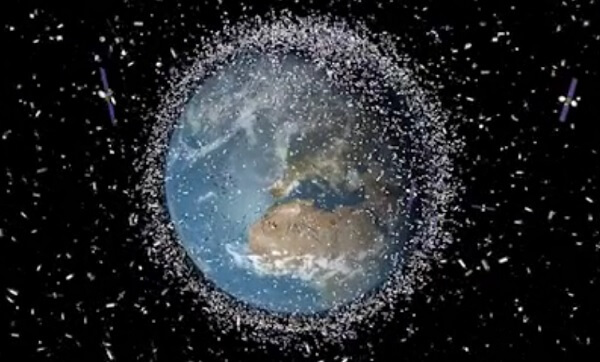At the end of last week, the European Space Agency's Sixth Spacefall Conference convened in the city of Darmstadt, Germany, to discuss the issue that is becoming a real problem that threatens the future of space exploration.

by Yair Mor, Opal site
Whether we noticed it or not, satellites have long since become an integral part of our lives. We use them to navigate while driving and walking, watch TV, surf the Internet, call distant parts of the world, monitor and predict the weather and many other lesser known uses for intelligence or other reasons. But the amount of flying objects that have been launched into space in the last decades has been accumulating, and now poses a risk to itself, and thus also to the various uses we make of it. Just yesterday we were informed that some object had damaged the array of solar cells of the International Space Station, and although astronaut Chris Hadfield wrote on Twitter that it was a "stone from the universe", space experts on earth were quick to hypothesize that it is actually a piece of a vessel sent into space by humanity.
At the end of last week, the European Space Agency's Sixth Spacefall Conference convened in the city of Darmstadt, Germany, to discuss the issue that is becoming a real problem that threatens the future of space exploration. According to the agency, there are currently around 17,000 man-made objects in orbit around the Earth monitored by space agencies, of which only around 1,000 are active satellites. The rest are remnants of satellites and launch rockets of satellites and shuttles, which have finished their duty but continue to revolve around the star since there is nothing to stop them from continuing. This has already caused 4 significant collisions in recent years, and several cases in which space agencies and commercial companies had to move the orbit of active satellites to avoid a collision with a fallout.
At the conference, scientists from various institutions presented data according to which the current state of the fallout, which includes every year a number of explosions of unused fuel reserves in flights that cause an increase in the number of fallout particles, may lead to the fact that by 2050 it will be very difficult to control the population of satellites and prevent collisions that will cause damage to the services they provide us or a lack of Ability to launch new missions into space for fear of intercepting shuttles and space vehicles by the fallout. Therefore, the officials agreed, it is necessary to act quickly to find ways to treat the space debris that humanity has left behind around the Earth. According to them, future space missions must be planned so that no additional waste is left, at the same time as the cleaning of the existing waste on the roads that are currently in early research stages.
The preferred way to overcome the problem is to cause the unnecessary particles to fall back to the ground. Agencies and companies hope to develop a way to do this by intercepting particles using laser cannons that will cause them to deviate from their orbits onto a crash course, as was done with the Russian Mir space station that was shot down into the ocean in March 2001. Alternatively, other scientists hope to build on weapons technology currently under development. and is designed to destroy hostile bodies in the air using lasers or other types of concentrated powerful waves. This way it will be possible to simply "melt" unnecessary particles. Both methods can be compared, quite basically, to a broom and a sponge. For now, at the conference, an Australian company called EOS Space Systems presented a laser system for "pushing" small particles in order to prevent collisions between them and active satellites. The system is intended for emergencies until the development of the desired solutions is completed.

4 תגובות
of course not. Mir was dropped into the ocean in a conventional way, this can be done more easily with a laser cannon - especially in cases where the object is moving without fuel.
"...Agencies and companies hope to develop a way to do this by intercepting particles using laser cannons that will cause them to deviate from their trajectory to a crash course, as was done with the Russian space station "Mir" which was dropped into the ocean in March 2001"
The above wording implies that the Mir space station was shot down using a laser cannon... I do not think so.
Someone here has seen "A Disturbing Truth" 🙂
This waste reduces (a little) the warming of the earth, now they will activate laser cannons which will contribute to the increase (a little) of the warming of the earth.
When will they realize that the real problem is global warming.